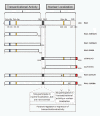Functional and cellular characterization of human Retinoic Acid Induced 1 (RAI1) mutations associated with Smith-Magenis Syndrome
- PMID: 20738874
- PMCID: PMC2939504
- DOI: 10.1186/1471-2199-11-63
Functional and cellular characterization of human Retinoic Acid Induced 1 (RAI1) mutations associated with Smith-Magenis Syndrome
Abstract
Background: Smith-Magenis Syndrome is a contiguous gene syndrome in which the dosage sensitive gene has been identified: the Retinoic Acid Induced 1 (RAI1). Little is known about the function of human RAI1.
Results: We generated the full-length cDNA of the wild type protein and five mutated forms: RAI1-HA 2687delC, RAI1-HA 3103delC, RAI1 R960X, RAI1-HA Q1562R, and RAI1-HA S1808N. Four of them have been previously associated with SMS clinical phenotype. Molecular weight, subcellular localization and transcription factor activity of the wild type and mutant forms were studied by western blot, immunofluorescence and luciferase assays respectively. The wild type protein and the two missense mutations presented a higher molecular weight than expected, localized to the nucleus and activated transcription of a reporter gene. The frameshift mutations generated a truncated polypeptide with transcription factor activity but abnormal subcellular localization, and the same was true for the 1-960aa N-terminal half of RAI1. Two different C-terminal halves of the RAI1 protein (1038aa-end and 1229aa-end) were able to localize into the nucleus but had no transactivation activity.
Conclusion: Our results indicate that transcription factor activity and subcellular localization signals reside in two separate domains of the protein and both are essential for the correct functionality of RAI1. The pathogenic outcome of some of the mutated forms can be explained by the dissociation of these two domains.
Figures





Similar articles
-
RAI1 transcription factor activity is impaired in mutants associated with Smith-Magenis Syndrome.PLoS One. 2012;7(9):e45155. doi: 10.1371/journal.pone.0045155. Epub 2012 Sep 18. PLoS One. 2012. PMID: 23028815 Free PMC article.
-
Molecular analysis of the Retinoic Acid Induced 1 gene (RAI1) in patients with suspected Smith-Magenis syndrome without the 17p11.2 deletion.PLoS One. 2011;6(8):e22861. doi: 10.1371/journal.pone.0022861. Epub 2011 Aug 8. PLoS One. 2011. PMID: 21857958 Free PMC article.
-
Detection of classical 17p11.2 deletions, an atypical deletion and RAI1 alterations in patients with features suggestive of Smith-Magenis syndrome.Eur J Hum Genet. 2012 Feb;20(2):148-54. doi: 10.1038/ejhg.2011.167. Epub 2011 Sep 7. Eur J Hum Genet. 2012. PMID: 21897445 Free PMC article.
-
Frameshift mutation hotspot identified in Smith-Magenis syndrome: case report and review of literature.BMC Med Genet. 2010 Oct 8;11:142. doi: 10.1186/1471-2350-11-142. BMC Med Genet. 2010. PMID: 20932317 Free PMC article. Review.
-
Smith-Magenis syndrome: haploinsufficiency of RAI1 results in altered gene regulation in neurological and metabolic pathways.Expert Rev Mol Med. 2011 Apr 19;13:e14. doi: 10.1017/S1462399411001827. Expert Rev Mol Med. 2011. PMID: 21545756 Review.
Cited by
-
GENETIC AND EPIGENETIC CAUSES OF OBESITY.Adolesc Med State Art Rev. 2017 Fall;28(2):379-405. Adolesc Med State Art Rev. 2017. PMID: 30416642 Free PMC article. Review.
-
Identification of Nine New RAI1-Truncating Mutations in Smith-Magenis Syndrome Patients without 17p11.2 Deletions.Mol Syndromol. 2014 Feb;5(2):57-64. doi: 10.1159/000357359. Epub 2014 Jan 7. Mol Syndromol. 2014. PMID: 24715852 Free PMC article.
-
Rai1 frees mice from the repression of active wake behaviors by light.Elife. 2017 May 26;6:e23292. doi: 10.7554/eLife.23292. Elife. 2017. PMID: 28548639 Free PMC article.
-
The role of the retinoids in schizophrenia: genomic and clinical perspectives.Mol Psychiatry. 2020 Apr;25(4):706-718. doi: 10.1038/s41380-019-0566-2. Epub 2019 Oct 30. Mol Psychiatry. 2020. PMID: 31666680 Free PMC article. Review.
-
Whole Exome Sequencing Reveals Homozygous Mutations in RAI1, OTOF, and SLC26A4 Genes Associated with Nonsyndromic Hearing Loss in Altaian Families (South Siberia).PLoS One. 2016 Apr 15;11(4):e0153841. doi: 10.1371/journal.pone.0153841. eCollection 2016. PLoS One. 2016. PMID: 27082237 Free PMC article.
References
-
- Redon R, Ishikawa S, Fitch KR, Feuk L, Perry GH, Andrews TD, Fiegler H, Shapero MH, Carson AR, Chen W, Cho EK, Dallaire S, Freeman JL, González JR, Gratacòs M, Huang J, Kalaitzopoulos D, Komura D, MacDonald JR, Marshall CR, Mei R, Montgomery L, Nishimura K, Okamura K, Shen F, Somerville MJ, Tchinda J, Valsesia A, Woodwark C, Yang F. et al.Global variation in copy number in the human genome. Nature. 2006;444:444. doi: 10.1038/nature05329. - DOI - PMC - PubMed
-
- Korn JM, Kuruvilla FG, McCarroll SA, Wysoker A, Nemesh J, Cawley S, Hubbell E, Veitch J, Collins PJ, Darvishi K, Lee C, Nizzari MM, Gabriel SB, Purcell S, Daly MJ, Altshuler D. Integrated genotype calling and association analysis of SNPs, common copy number polymorphisms and rare CNVs. Nat Genet. 2008;40:1253. doi: 10.1038/ng.237. - DOI - PMC - PubMed
-
- McCarroll SA, Kuruvilla FG, Korn JM, Cawley S, Nemesh J, Wysoker A, Shapero MH, de Bakker PI, Maller JB, Kirby A, Elliott AL, Parkin M, Hubbell E, Webster T, Mei R, Veitch J, Collins PJ, Handsaker R, Lincoln S, Nizzari M, Blume J, Jones KW, Rava R, Daly MJ, Gabriel SB, Altshuler D. Integrated detection and population-genetic analysis of SNPs and copy number variation. Nat Genet. 2008;40:1166. doi: 10.1038/ng.238. - DOI - PubMed
Publication types
MeSH terms
Substances
Grants and funding
LinkOut - more resources
Full Text Sources
Medical
Miscellaneous

